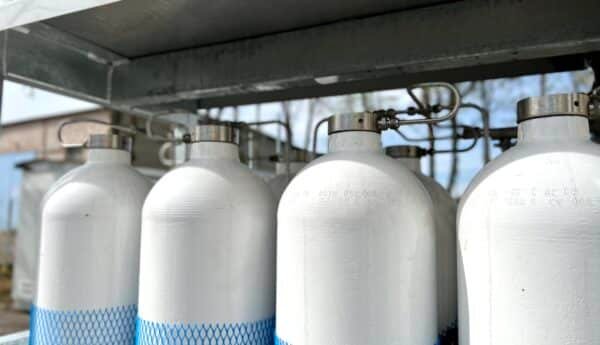Hydrogen storage is a central building block in the hydrogen chain at the crossroads of logistics (transport from production to distribution) and use (hydrogen embedded in vehicles). Its cost, technical constraints and various options have led hydrogen players, from research centres to manufacturers, to explore numerous avenues.
Gaseous, liquid, solid
AAfter a brief technical reminder, this article aims to trace the evolution of technological choices for hydrogen storage in the light of strong development in this energy sector.
Hydrogen at room pressure and temperature is in the gaseous state. A first form of storage is therefore hydrogen under pressure (ranging from a few bars to 1,000 bars). Simple tanks are made of steel and the more complex ones are made of composites and carbon fibers.
The gas can also be cooled to cryogenic temperatures below -253 °C and stored in cryogenic tanks.
The properties of hydrogen also make it storable in metal powders at room pressure and temperature by adsorption.
Finally, the affinity of hydrogen with many molecules allows it to be integrated into organic compounds (hydrogenated oils, carbon chains) or inorganic compounds (ammonia, silicon hydride or others).
These different forms of storage can then take different transport routes. Gaseous storage is mainly transported by road but also by pipeline. Liquid hydrogen and chemical compounds are also transported by road and more recently by ship. Solid storage, on the other hand, is not very subject to transport and remains used for stationary purposes.
Mature techniques and new applications
Historically, in industrial uses of the process (refinery, fertilizers and others) hydrogen is stored and distributed (when it is not produced on site) in gaseous form at 200 bars of pressure for reasons of logistical optimum (quantity of hydrogen transported vs. number of delivery rotations). This storage and transport is carried out using unreinforced steel tanks (known as “Type I”).
Storage in liquid form at -253 °C can be justified in certain cases of industrialists who are heavy consumers of hydrogen and located far from production centers. This cryogenic form is also preferred in the particular case of rocket propulsion.
Finally, the solid form (by adsorption on metal alloys) has been the subject of research and some commercial developments without, however, finding its mass market at present.
Looking ahead to the 2030s, several changes in hydrogen storage could occur:
First of all, massive storage in underground cavities could experience significant growth based on a strong penetration of renewable energies in the European network, but also on tensions in the supply of natural gas. A hydrogen-methane mix would make it possible to overcome a gas shortage. Projects such as Hypster, led by Storengy, demonstrate the feasibility of these massive storages.
Then, the internationalization of the hydrogen market based on high consumption in certain regions of the world (EU, EU, Asia) and on exports by other regions rich in renewable resources (Africa, South America), will promote storage by chemical vectors (ammonia, hydrogenated oils) or even by liquid hydrogen. International transport of liquid hydrogen and ammonia has already taken place.
Which model?
These two trendsThese funds will promote the storage and transport of hydrogen through hydrogen pipelines across Europe as planned in the “European Hydrogen Backbone” project supported by many European gas network operators. Ports will also be central platforms in these future networks.
CHowever, it may be wrong to transpose the hydrogen model with that of gas and oil. With decentralized production and uses close to the production sites, also in view of the transport and storage costs, it is likely that transport and storage are limited to short-distance and short-time uses.
In other words, the hydrogen economy could be, unlike those of oil and gas energies, a delocalized and not a globalized economy. What country would indeed have an interest in producing hydrogen from its balance sheet intended to travel thousands of kilometers with prohibitive transport and storage costs, unless these are significantly reduced with future innovations? The energy world of the future could therefore be radically different and, perhaps, generate fewer conflicts in the world!
Article produced in collaboration with Karel Hubert, President of the hydrogen research firm Enerka
(karel.hubert@enerka-conseil.com).

